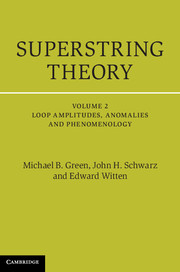Book contents
- Frontmatter
- Contents
- Preface to the 25th Anniversary Edition
- 8 One-loop diagrams in the bosonic string theory
- 9 One-loop diagrams in superstring theory
- 10 The gauge anomaly in type I superstring theory
- 11 Functional methods in the light-cone gauge
- 12 Some differential geometry
- 13 Low-energy effective action
- 14 Compactification of higher dimensions
- 15 Some algebraic geometry
- 16 Models of low-energy supersymmetry
- Bibliography
- References
- String Field Theory
- Index
15 - Some algebraic geometry
Published online by Cambridge University Press: 05 September 2012
- Frontmatter
- Contents
- Preface to the 25th Anniversary Edition
- 8 One-loop diagrams in the bosonic string theory
- 9 One-loop diagrams in superstring theory
- 10 The gauge anomaly in type I superstring theory
- 11 Functional methods in the light-cone gauge
- 12 Some differential geometry
- 13 Low-energy effective action
- 14 Compactification of higher dimensions
- 15 Some algebraic geometry
- 16 Models of low-energy supersymmetry
- Bibliography
- References
- String Field Theory
- Index
Summary
In chapters 12 and 14 we developed some simple tools in differential geometry and used them to gain some insight concerning the compactification of hidden dimensions as well as some insight concerning phenomena on the string world sheet. We now turn our attention to some more specialized mathematical tools involving complex manifolds and algebraic geometry. Again, the motivation is twofold. The world sheet of a string is a complex manifold – a Riemann surface, in fact – and as string theory develops, the deeper study of world-sheet phenomena is likely to involve deeper aspects of algebraic geometry, which have already begun to enter in recent works on multiloop diagrams. Also, algebraic geometry has been a tool in recent attempts to formulate more realistic models of string compactification.
In this chapter, we develop some of the basic concepts of complex geometry, with examples selected for their role both in world-sheet phenomena and in the study of compactification. We will unfortunately not be able to describe in this book recent work on the application of algebraic geometry to multi-loop diagrams. This subject is probably not yet ripe for synthesis; and the requisite mathematical machinery is more extensive than we will be able to present even in this moderately lengthy chapter. By laying at least some of the elementary foundations we hope to facilitate the task of the reader who wishes to delve further elsewhere.
- Type
- Chapter
- Information
- Superstring Theory25th Anniversary Edition, pp. 413 - 474Publisher: Cambridge University PressPrint publication year: 2012



